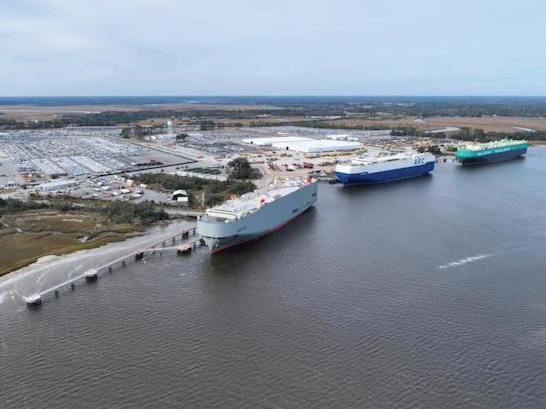Europe’s automotive logistics providers have experienced a protracted period of turbulence.

European automotive logistics providers, like their counterparts around the world, have experienced a protracted period of turbulence, from the first wave of the COVID pandemic in March 2020 and the impact of significant shortages of semi-conductor/microchips, crucial to modern vehicle manufacturing, to disruption from Russia’s invasion of Ukraine.
The upheaval has manifested itself in the form of inconsistent volumes handled at the ports, a high number of unfinished vehicles at some facilities and a serious lack of road, rail, and ro/ro capacity, leading to longer dwell and lead times and a shortage of labor – each posing serious challenges to the smooth running of the sector which has also had to adapt to the sharp rise in imports from China and to the specific demands of handling electric vehicles.
More recently, the threat of attacks on ships in the Red Sea by Houthi militia has brought fresh disruption to automakers’ supply chains, forcing ocean shipping lines to avoid the Suez Canal and re-route vessels around Africa, thus lengthening transit times significantly.
Meanwhile, on the automotive manufacturing front, a recovery is taking shape. Output was firmly in growth mode last year, according to analysis by S&P Global Mobility, published in December 2023, with annual global light vehicle production expected to total 89.8 million units - “a healthy 9.0% improvement over 2022 levels that exceeds expectations in several regions, further building on implied inventory restocking. This marks a welcome return to pre-pandemic levels of production on a global basis, powered by gains in mainland China and India.”
Demand Driven Model
For 2024, S&P Global Mobility continues to see a general production outlook that is reliant on a more traditional demand-driven model. “With inventories reaching equilibrium in many markets, global production growth is expected to slip into a mild reverse as the industry navigates recovery after a tumultuous several years.”
While a degree of normality and stability appears to be returning to automotive production, logistics providers continue to operate in a volatile environment where macro-economic uncertainty and geo-political tensions show no sign of easing.
“It seems every year brings a new crisis: COVID, material shortages (especially in semiconductors/microchips), capacity, and now high stock levels are building,” Mike Sturgeon, Executive Director, European Car-Transport Group (ECG) The Association of European Vehicle Logistics, told AJOT in an interview.
“It’s worth remembering that the capacity crisis which began in 2022 was mostly a direct result of the first two (factors) as the industry was left for more than two years to survive in a situation where volumes were low and completely unpredictable, and manufacturers stopped even attempting to provide any sort of forecast for their requirements in this period. Inevitably, resources were downsized by the carriers.”
Commenting on the outlook for road transporter capacity and the availability of drivers, as well as the supply of vehicle-carrying ships, Sturgeon said: “In Europe, road transport capacity has improved a little – not just due to transporter fleets increasing again but also to some reduction in demand. Many OEMs still lease dedicated trucks in order to secure capacity, but these are operated inefficiently (often running empty on the return leg). The sector really needs to return to a normal way of working where LSPs optimize truck capacity and minimize empty running. Until this is allowed to happen, costs and other associated measures, such as emissions, will continue to be higher than they need to be.”
Truck Drivers turning to Auto Logistics
Turning to driver shortages, a global issue, Sturgeon said the pressure has eased for the moment but only because of the economic downturn. This has resulted in less demand for general haulage and led to more drivers coming into automotive logistics.
“But be in no doubt; this situation is temporary – the driver shortage has not gone away and in fact will get much, much worse in the coming years,” Sturgeon warned.
As for ocean shipping, he said capacity was reduced in 2020/21 and then demand from Asia started growing rapidly. In the deep-sea sector especially, a huge number of orders were placed for very large car-carrying ships from late-2022 when order books were at almost zero.
“Some of these ships have already entered service and many more will be delivered in the next 2-3 years. They had been expected to bring deep sea supply and demand back into some sort of balance. However, the situation in the Red Sea has changed all of that as sailings from Asia to Europe are now being routed around Africa adding up to 10 days to a journey. Overnight, this has effectively reduced the capacity in this sector significantly and also created a new crisis in the short-sea trade as the deep sea vessels are no longer passing through the Mediterranean Sea.”
He explained that some vehicles therefore get dropped off in the ‘wrong’ port, for example, in Northern Europe and need to be repositioned by the short-sea fleet. Others used to be picked up enroute by deep-sea vessels, for example, vehicles built in Turkey destined for the European market and will now need to be picked up by short-sea services instead.
“In addition, vehicle stocks are generally now very high and almost every port terminal and car storage compound in Europe has been full for ages. There is literally nowhere to put vehicles and the resulting port congestion forces many ships to wait outside some ports before they can load/unload and these delays also reduce the effective capacity of the sector,” he added.

Follow us on social media: